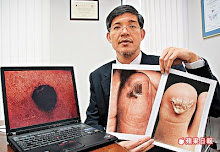
An Endometriotic Cyst
The Stages of Endometriosis
By Eric A. Daiter MD
Endometriosis symptoms can vary greatly from one person to the next. Symptoms can be severe while the endometriosis itself is mild. Mild symptoms can be present or even undetectable and endometriosis can be very advanced. The endometriosis symptoms you experience could have no correlation at all to the extent or severity of the endometriosis itself.
Endometriosis tissue is much like the lining of your uterus. It reacts hormonally the same as the uterine lining. It grows and sheds along with your menstrual cycle. It is widely believed that in some cases, when the uterine lining is shed, it does not leave the body as it is supposed to. Instead, it travels up the fallopian tubes and into the abdominal cavity. Here, it infests the reproductive organs, surrounding tissues and even the nearby organs.
Endometriosis is a progressive disease and can get worse over time. It can spread to the lower back, bowels, kidneys, lungs and other organs, inhibiting organ function. This is why it is particularly important to treat endometriosis even if you do not have infertility concerns.
Symptoms can be mild or severe. They include heavy, painful or irregular periods. Lower back pain and kidney problems are also not uncommon. Many women are not diagnosed with endometriosis until they experience infertility. Endometriosis is usually discovered during a diagnostic laparoscopic surgery while an infertility specialist is looking for infertility causes. A laparoscopic endometriosis treatment may be necessary to restore fertility. Laparoscopy is the only way to definitively diagnose endometriosis.
Endometriosis severity is measured in stages. Stage 1 is referred to as minimal endometriosis and may or may not have an effect on fertility. Stage 1 endometriosis is usually treated with medications unless you are trying to conceive. If you are having trouble conceiving, then even minimal amounts of endometrial implants and lesions may need to be surgically removed. Another reason to treat stage 1 endometriosis is because it is progressive and can lead to dangerous organ damage down the line.
Stage 2 endometriosis is mild, but more than just the occasional lesion or implant is visible. Stage 2 endometriosis usually means that at least one of the ovaries has endometriosis present. This can lead to your fallopian tubes being blocked by scar tissues or the ovaries themselves being compromised by the present implants.
Stage 3 endometriosis is considered moderate. Stage 3 is used to describe endometriosis, usually on both ovaries as well as the uterus. Implants and lesions may be deeper and take up more area than stage 2 implants and lesions. Surgical treatment of stage 3 and stage 4 endometriosis historically has had the greatest impact on fertility associated with endometriosis.
Stage 4 is the most severe. Stage 4 is used to describe endometriosis that is prominent in the abdominal cavity. Stage 4 endometriosis can affect many surrounding organs and be very dangerous. This is the stage most commonly associated with infertility.
If you are experiencing any endometriosis symptoms and are having trouble conceiving, then you could have an advanced level of endometriosis. You should never ignore endometriosis symptoms or prolong treatment.
The article The Stages of Endometriosis was Submitted by Eric A. Daiter MD through Articles.GetACoder.com network. Here's the additional information: This information is brought to you by Dr. Daiter, Eric MD. About the Author: Dr. Eric Daiter MD, the medical director of The NJ Center for Fertility and Reproductive Medicine, LLC.
Photo credit: http://farm4.static.flickr.com
